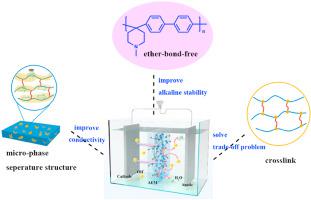Journal of Power Sources ( IF 8.1 ) Pub Date : 2021-01-02 , DOI: 10.1016/j.jpowsour.2020.229429 Xinming Du , Hongyu Zhang , Yongjiang Yuan , Zhe Wang

|
The ether-bond-free poly(biphenyl piperidine)s are prepared to improve the alkaline stability of the anion exchange membrane (AEMs). At the same time, the construction of micro-phase separation structure is a good way to solve the “trade-off” problem between ionic conductivity and stability of AEMs. In this study, we report a new method for constructing micro-phase separation structures based on “main-chain type” AEMs and a crosslinking strategy that does not sacrifice ion exchange capacity. A series of poly(biphenyl piperidine)s AEMs (PAP–OH–x) are prepared by introducing 2-bromoethanol and 1,6-dibromohexane to form piperidine cationic groups and cross-linked structure. The structure of hydrophilic/hydrophobic phase separation is confirmed by TEM images. The cross-linked membrane of poly(biphenyl piperidine)s (PAP–OH–8%) membrane exhibits high conductivity of 0.081 S/cm with a rational water absorption (55.6%) and low swelling ratio (11.8%) at 80 °C, and also preserves the hydroxide conductivity (89.2% retention) after testing in a 5 M NaOH aqueous solution at 80 °C for 30 days, exhibits high alkaline stability. Furthermore, a single H2/O2 fuel cell with poly(biphenyl piperidine)s (PAP–OH–8%) membrane exhibits the open circuit voltage of 1.02 V and the peak power density of 290 mW/cm2 at 60 °C.
中文翻译:

基于聚(芳基哌啶)交联膜构建微相分离结构以提高阴离子交换膜的性能
制备无醚键的聚(联苯哌啶)以提高阴离子交换膜(AEM)的碱性稳定性。同时,微相分离结构的构建是解决离子电导率与AEMs稳定性之间“权衡”问题的好方法。在这项研究中,我们报告了一种基于“主链型” AEM和不牺牲离子交换能力的交联策略构建微相分离结构的新方法。通过引入2-溴乙醇和1,6-二溴己烷以形成哌啶阳离子基团和交联结构,制备一系列聚联苯哌啶的AEM(PAP-OH-x)。通过TEM图像确认了亲水/疏水相分离的结构。聚(联苯哌啶)(PAP–OH–8%)膜的交联膜在80°C时具有0.081 S / cm的高电导率,具有合理的吸水率(55.6%)和低溶胀率(11.8%)。在5 M NaOH水溶液中于80°C下测试30天后,还可以保持氢氧化物的电导率(保留89.2%),具有很高的碱性稳定性。此外,单个H具有聚(联苯哌啶)(PAP–OH–8%)膜的2 / O 2燃料电池在60°C下的开路电压为1.02 V,峰值功率密度为290 mW / cm 2。


















































 京公网安备 11010802027423号
京公网安备 11010802027423号